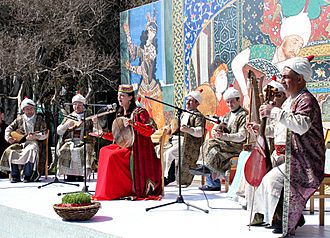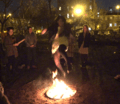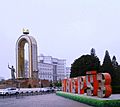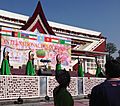Nowruz facts for kids
Quick facts for kids Nowrūzنوروز Nevruz |
|
|---|---|
 |
|
| Significance | New year holiday |
| Celebrations | The Haftsin setting, Chahârshanbe Sûrî, Sizdah Bedar, etc. |
| Date | March 20, 21 or 22 |
| 2025 date | |
Nowruz (pronounced "No-rooz") is the traditional New Year celebration for many people around the world. Its name means "New Day" in Persian. This special holiday marks the first day of spring. It is a time for new beginnings and celebrating nature's rebirth.
Nowruz is celebrated on the spring equinox. This is the exact moment when the sun crosses the celestial equator. On this day, the amount of daylight and darkness are almost equal. This usually happens on March 20, 21, or 22. Nowruz is the start of the year in the Persian calendar.
People have celebrated Nowruz for thousands of years. It began in ancient Persia, which is now Iran. Over time, this celebration spread to many different countries. Today, people from various cultures and religions celebrate Nowruz. This includes communities in Iran, Tajikistan, Pakistan, Afghanistan, and many other parts of the Middle East and Central Asia.
Contents
What is Nowruz?
Nowruz is more than just a new year. It is a time to welcome spring and new life. It is a very old holiday that has been celebrated for centuries. Many people see it as a day when good things begin.
When is Nowruz Celebrated?
Nowruz is always celebrated at the exact moment of the spring equinox. This means the date can change slightly each year. It is usually on March 20, 21, or 22. The celebration often lasts for several days or even weeks.
Where is Nowruz Celebrated?
Nowruz started in ancient Persia. Today, it is celebrated by millions of people. These celebrations happen in many countries. They include Iran, Afghanistan, Tajikistan, Azerbaijan, Uzbekistan, Kazakhstan, Kyrgyzstan, and parts of Turkey and Iraq. Each country has its own special traditions for Nowruz.
Nowruz Traditions
Nowruz is full of fun and meaningful traditions. Families often spend time together. They prepare special foods and decorate their homes. Many traditions focus on cleaning, renewal, and good luck for the new year.
Haft-Seen Table
One of the most important traditions is setting up a "Haft-Seen" table. "Haft" means seven, and "Seen" refers to the letter 'S' in Persian. This table has seven items that start with the letter 'S'. Each item symbolizes something special:
- Sabzeh: Wheat, barley, or lentil sprouts growing in a dish. This symbolizes rebirth and growth.
- Samanoo: A sweet pudding made from wheat germ. This symbolizes power and strength.
- Senjed: Dried oleaster fruit. This symbolizes love and wisdom.
- Sir: Garlic. This symbolizes health and medicine.
- Sib: Apples. This symbolizes beauty and health.
- Sumac: A spice made from crushed berries. This symbolizes the sunrise and good triumphing over evil.
- Serkeh: Vinegar. This symbolizes age and patience.
Other items are often added to the Haft-Seen table. These might include a mirror for reflection, candles for light, painted eggs for fertility, and coins for wealth. A holy book or a book of poetry, like the Shahnameh, is also often placed on the table.
Chaharshanbe Suri
The Tuesday evening before Nowruz is called "Chaharshanbe Suri." This is a fire festival. People gather and jump over small bonfires. As they jump, they say a special phrase. This tradition is meant to burn away sickness and bad luck from the past year. It also brings health and happiness for the new year.
Sizdah Bedar
Thirteen days after Nowruz, families celebrate "Sizdah Bedar." This day is often called "Nature's Day." People go outdoors for picnics. They spend the day in parks, fields, or by rivers. It is a time to enjoy nature and have fun with family and friends. On this day, the "sabzeh" from the Haft-Seen table is often thrown into a running stream or river. This symbolizes giving back to nature and letting go of bad luck.
Other Celebrations
Many other traditions are part of Nowruz. People often visit family and friends. They exchange gifts, especially for children. Special foods are prepared, like different kinds of rice dishes and sweets. Music and dancing are also common during this festive time.
Images for kids
-
Charshanbe Suri in New York City, March 2016
-
A bas-relief at the Apadana, Persepolis, depicting Armenians bringing their famous wine to the king
-
Haji Firuz performers on a road to Tehran
-
Traditional dancing during a Nowruz festival in Paris
-
Painting huge eggs for Nowruz in Tehran.
See also
 In Spanish: Nouruz para niños
In Spanish: Nouruz para niños

















